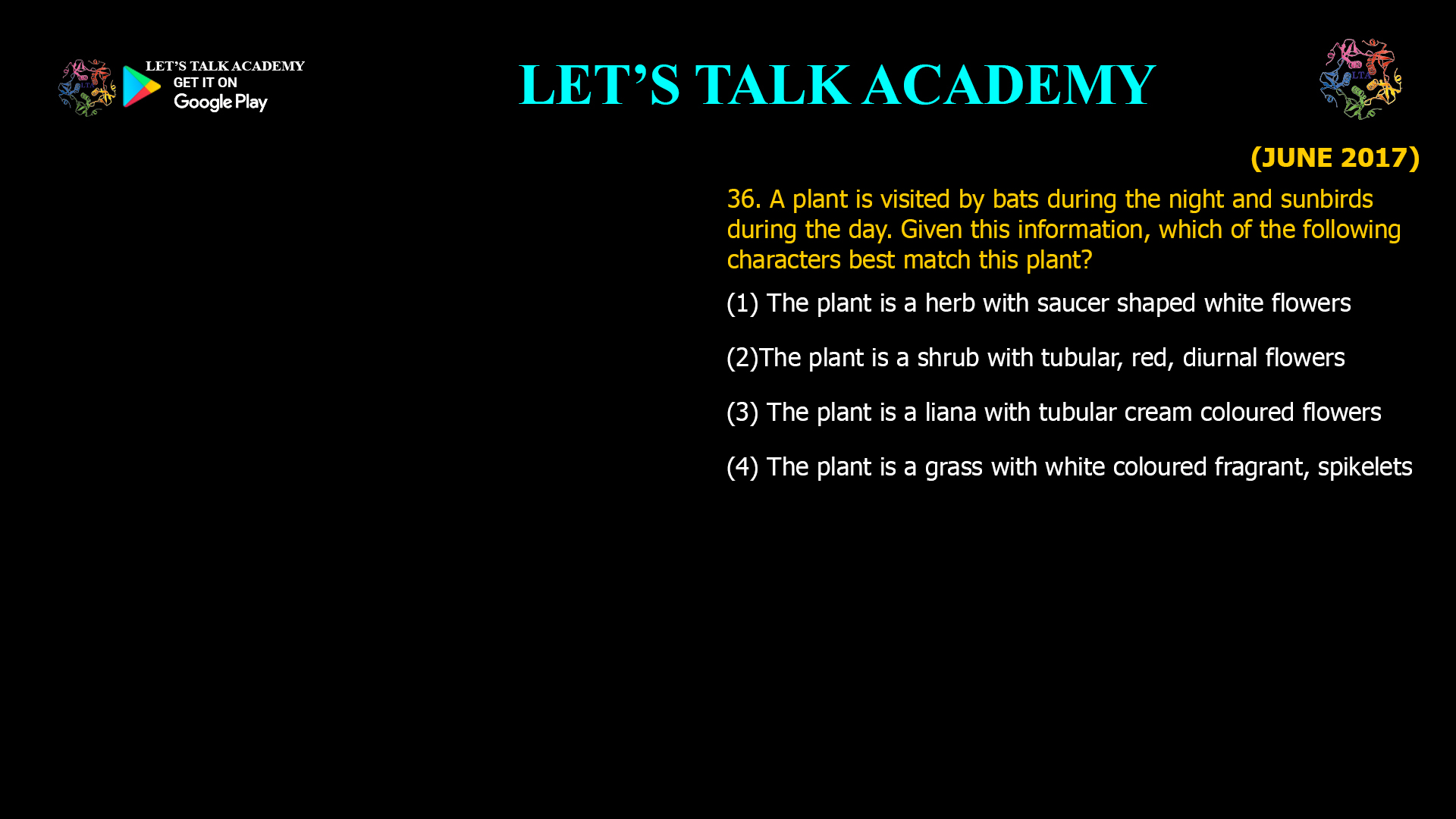36. A plant is visited by bats during the night and sunbirds during the day. Given this
information, which of the following characters best match this plant?
(1) The plant is a herb with saucer shaped white flowers
(2)The plant is a shrub with tubular, red, diurnal flowers
(3) The plant is a liana with tubular cream coloured flowers
(4) The plant is a grass with white coloured fragrant, spikelets
Key Pollinator Traits
Bats (Chiropterophily)
-
Active at night
-
Attracted to large, robust, pale or cream-colored flowers
-
Prefer flowers with ample nectar and a strong, musky or fermenting scent
-
Flowers are often tubular or bell-shaped to accommodate bat snouts and tongues
Sunbirds (Ornithophily)
-
Active during the day
-
Attracted to brightly colored (often red, orange, or yellow), tubular flowers
-
Flowers are usually open during the day and provide copious nectar
-
Sunbirds have long, curved beaks suited for tubular flowers
Matching the Plant to Its Pollinators
Given the plant is visited by both bats (at night) and sunbirds (during the day), the ideal floral traits would be:
-
Tubular flowers (accommodating both bat snouts and sunbird beaks)
-
Cream or pale coloration (visible to bats at night)
-
Ample nectar (to attract both types of pollinators)
-
Accessible to both flying mammals and birds
-
Likely to be a liana or shrub (elevated or hanging flowers for bats to access easily)
Evaluating the Options
-
The plant is a herb with saucer shaped white flowers
-
Saucer-shaped flowers are more likely to attract insects or butterflies, not bats or sunbirds.
-
-
The plant is a shrub with tubular, red, diurnal flowers
-
Red, diurnal flowers are classic for sunbird (bird) pollination, but bats are not typically attracted to red or diurnal-only flowers.
-
-
The plant is a liana with tubular cream coloured flowers
-
Tubular, cream-colored flowers fit both bat and sunbird pollination syndromes. Lianas often have hanging or exposed flowers, accessible to bats at night and sunbirds during the day.
-
-
The plant is a grass with white coloured fragrant, spikelets
-
Grasses are usually wind-pollinated, not adapted for bats or sunbirds.
-
The Best Match
The correct answer is:
(3) The plant is a liana with tubular cream coloured flowers
Why This Is Correct
-
Tubular shape: Accessible to both bats and sunbirds.
-
Cream color: Attracts bats at night.
-
Liana growth form: Flowers are accessible to flying pollinators.
-
Nectar-rich: Likely to satisfy both bats and sunbirds.
Conclusion
Plants visited by both bats and sunbirds typically have tubular, pale-colored flowers that are accessible to both pollinators. The liana with tubular cream-colored flowers is the best match, reflecting a fascinating adaptation to attract both nocturnal and diurnal visitors—maximizing pollination opportunities and reproductive success.




2 Comments
Kajal
November 9, 2025Option 3
Sakshi Kanwar
November 27, 2025The plant is a liana with tubular cream coloured flowers